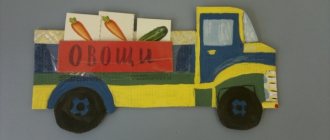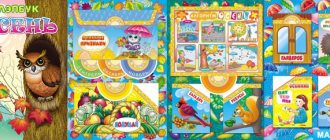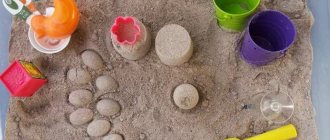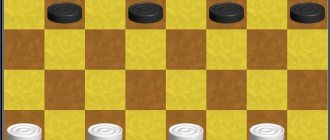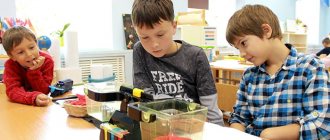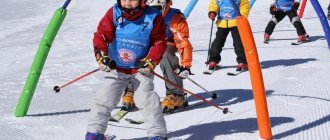Learning to play mosaic. Methodological development on correctional pedagogy (junior group)
Learning to play mosaic.
All parents want to see their children healthy, happy and successful in life. In order for a child to grow up as a harmoniously developed personality, it is necessary to make every effort for his upbringing and development. Games help us with this, because play is the main and leading activity of preschool children. Today there are a huge number of games. Among such diversity, I would like to draw your attention to a fairly simple and, at the same time, very useful game - “Mosaic”.
“Mosaic” is an original, exciting, educational game for children of all ages, combining elements of a construction set, a board game, a puzzle and a creativity kit.
- mosaic develops fine motor skills of the hands
- develops and improves sensory standards (color, shape)
- develops mental processes: attention, memory, thinking, imagination, fantasy, speech
- develops children's cognitive activity
- develops constructive abilities
- develops mathematical abilities in children:
- develops artistic taste in children
- Our task is to teach the child to play mosaic, through which he would develop himself independently.
- Let's start with the fact that before a child begins to develop while playing with mosaics, he needs to be captivated and interested in this game. After all, if you just put a mosaic on the table, he is unlikely to do anything interesting and will soon get tired of it.
- First, introduce your child to the game and its details. As a rule, a game set consists of a field (board, colored elements (chips) and pictures - instructions. Show the children the mosaic board, pay attention to the holes. Take one mosaic element, examine it with the children, show that it has a “hat” and “leg" (“like a mushroom”). The cap of a chip for children 2-3 years old must be hexagonal. Show how to take a chip, teach children to take chips with a pinch: with three fingers - middle, index, thumb, how to insert a mosaic element into the hole of the board. Insert 2-3 mosaic elements. Let the child first try to get the pieces out on his own, if he doesn’t succeed, help: from the back of the board, push the piece so that the cap rises a little. The child’s feeling of success is very important here. And then let him try to insert the elements into the holes.
Can be accompanied by the following game situations:
Game situation “It’s raining” - single placement (i.e. randomly across the entire field)
Game situation “Path” - laying out close to each other (horizontally and vertically)
Game situation “A duck is swimming in a puddle” - laying out close to each other (without gaps)
- Explore the colors of mosaic elements with your children. Lay out the mosaic pieces in front of your child and list the main colors. Pointing to one or another, name the color. You can ask them to sort the chips by color.
- Lay out a path of 3-4 elements in front of your child and ask him to make the same one below, under yours, that is, let him repeat the order of colors. It is necessary to lay out the path from left to right in order to orient the child to the correct letter.
- Gradually increase the number of elements and complexity of the compositions. At the same time, help your child if something doesn’t work out for him, but you shouldn’t assemble the mosaic instead of him. Guide him, suggest the sequence of actions. Be sure to praise your child for his efforts. Rejoice in your child's success with him. And most importantly, convince the child that he can do anything, that he will succeed. It is very important.
Educational games with pebbles for preschoolers 4-7 years old
Educational games for preschoolers “Magic pebbles”
Author:
Tatyana Mikhailovna Chentsova, teacher at the “Smile” Children’s Educational Institution, Labytnangi, Yamalo-Nenets Autonomous Okrug
Description of the material: The material will be useful to teachers working with preschoolers, as well as parents. Sea and river smooth stones (pebbles) are an excellent natural material for activities with children. Their smooth surface lends itself well to painting and is evenly varnished. Pebbles are also good in natural colors, which can vary from white to burgundy and black with natural inclusions of various shades. Playing with pebbles has an excellent tonic and healing effect. All activities involving the use of small objects must be carried out under the strict supervision of adults! Game options: Mathematical Lotto First option: Goal: to develop attentiveness, concentration, the ability to quickly navigate game cards, to consolidate children’s knowledge of numbers from 1 to 20. Age: 6-7 years. Rules of the game: The presenter, without looking, takes one keg out of the bag and loudly and clearly pronounces its number out loud, and then puts the keg aside. Thus, with each number announced, there is 1 less keg in the bag. After this, each player checks whether he has such a number on his game card. If the number announced by the leader is on the game card, the player covers it with pebbles. If there is no such number, then the player waits for the next number to be announced. The kegs are drawn until one of the players wins (i.e., the first one to fill out their game card wins).
Second option: Goal: to develop observation, attention, fine motor skills of the fingers, mental counting, the ability to correlate quantities with numbers. Age: 5-6 years. Rules of the game: In this lotto game, the child’s task is to find out the number on the card and place the corresponding number of pebbles on the empty playing field.
“Mosaic” Goal: to develop motor skills of the fingers, dexterity, finger mobility, imagination, perseverance, children's creativity, to promote the development of independence in work. Age: 4-5 years. Rules of the game: It is better to work with mosaics in stages. At the first stage, children get acquainted with the mosaic field, learn to lay out pebbles according to drawings - samples: mushroom, house, boat. At the second stage, children are laid out according to their plans, they independently come up with their own options and create them on a mosaic field. “Tic Tac Toe” Purpose of the game: to develop attention, memory, learning to distinguish between concepts such as “diagonally”, “vertically”, “horizontally”. Age: 6–7 years. Rules of the game: You need to line up a row of pebbles “X” and “O” diagonally, vertically or horizontally. But first you should explain the meaning of these words, since not all children may be familiar with them. Explain how the pebbles can be placed on the playing field, and which combination is winning.
Labyrinths Goal: to develop logical and spatial thinking, attention, such qualities as determination, variability, concentration, perseverance. Age: 5-7 years. Game task: Go through the maze
“Once upon a time there was a caterpillar” Purpose: to develop fine motor skills of the fingers, to practice orientation on the plane of a sheet, to develop in children creative thinking and imagination when composing fairy tales based on the picture and the title of the fairy tale, to teach coherently, consistently presenting the course of an invented fairy tale. Age: 5-6 years. Rules of the game: Children pick up pebbles and arrange them in the shape of a caterpillar. And then they come up with a continuation of the fairy tale. Once upon a time there was a little caterpillar.
And then one day... Children come up with a continuation of the fairy tale
Sand therapy First option: “Sand hide and seek” Goal: to develop fine motor skills of the hands, tactile sensations, and the child’s interest in experimental activities. Age: 4-5 years. Game task: Find the hidden pebbles in the sand.
Second option: “Creating patterns in the sand” Goal: to develop fine motor skills, imagination, and tactile sensations. Game task: Lay out patterns on the sand (for example, a house, a sun, a flower, etc.)
We recommend watching:
Psychological game for children 5-7 years old. Friendly family Role-playing games in kindergarten Art therapy in kindergarten. Drawing with semolina Games with paper for preschool children
Similar articles:
Games for the emotional development of children 3 and 4 years old
Games for children 2 and 3 years old to develop dexterity
Games that develop motor skills in children 2 and 3 years old
Educational games in pictures for children 4-5 years old
Games for preschoolers on the topic: Transport
Mosaic as a gaming technology in working with preschoolers
Natalia Lyakutina
Mosaic as a gaming technology in working with preschoolers
Introduction
All adults accompanying children want to see them healthy and educated. In order for a child to grow up as a harmoniously developed personality, it is necessary to put a lot of effort into his upbringing and development. And in this, taking into account the specifics of childhood, didactic games help a lot.
Among the huge variety of educational games and toys that currently exist, I would like to pay special attention to a fairly simple, familiar to everyone from childhood and, at the same time, very useful game - mosaic . Mosaic is an original , exciting, educational game for children of all ages, combining elements of a construction set, a board game, a puzzle and a creativity kit. With its help, you can lay out a variety of patterns and even create entire paintings. The role of mosaics in a child’s development is difficult to overestimate. However, not every adult understands the significance of such a simple toy for a child at first glance. Many people think that this is not at all difficult: just sit down and stick in the chips. We often hear parents complain that their child quickly loses interest in mosaics . Now he has already set up the paths, windows, fences, but is not yet ready to assemble the patterns according to the diagrams that come with the kit. the mosaic around the room a little more , and that’s it – the toy was forgotten.
At first glance, playing with mosaics seems like an empty activity that helps kill time, but this is far from the case. Behind the external simplicity and accessibility lies a complex, subtle, multifaceted activity that helps to develop a child. games develop :
mental processes;
cognitive activity;
constructive abilities (ability to act according to a pattern, pattern)
;
mathematical abilities (counting, spatial orientation)
;
fine motor skills;
artistic taste;
volitional personality traits (commitment, perseverance, etc.)
.
In addition, in the process of playing with mosaics , the child accumulates much-needed practical experience in object-based actions. Communicating with an adult during play, the baby not only begins to better understand the speech addressed to him, but also actively speak. The experience of joint activities is invaluable for a child: it is in games with adults or peers that he acquires the ability to build relationships with the outside world.
A study of the existing theoretical and practical experience of preschool educational institutions on this issue shows that there is no clear system for working with mosaics that has a goal, successive stages and planned results. This determined the relevance of this methodological development , the purpose of which is to familiarize teachers with the use of mosaics as a gaming technology aimed at the comprehensive development of preschool children .
Content
«Mosaic as a gaming technology in working with preschoolers»
Goal: development of mental processes in preschool .
Stages of technology :
1) organization of gaming activities without a playing field ;
2) organization of gaming activities with a playing field ;
3) the use of games with mosaics during joint activities between an adult and children.
Planned results:
— development of mental processes in preschool children ;
— improving motor dexterity of the fingers;
— development of volitional qualities of the individual.
At the first stage of technology implementation, work is carried out with mosaic details without using the playing field . This gives children the opportunity to become familiar with a variety of colors, sizes and shapes of parts. At this stage, children are taught to pick up only one piece of the mosaic and hold it correctly, i.e. by the hat. In play activities, mosaic are proposed to be used as substitute objects (children treat dolls with them like candy; transport them as cargo in a car, etc.). Then games are offered to sort the pieces: by color, size, quantity.
The simplest and safest is a large mosaic , the details of which are hexagons resembling honeycombs, and the playing field is a plate without holes. The details of such a mosaic are simply placed on top of the convex shapes of the playing field , and the fastening most closely matches the level of development of dexterity of a small child’s fingers. For games with children over 3 years old, the so-called classic mosaic , the parts of which consist of a stem and a cap.
The second stage of the implementation of gaming technology is the introduction of children to the space of the playing field , which occurs in a certain sequence and is accompanied by the creation of a gaming situation :
1. Single laying out (i.e. randomly across the entire field)
Game situation “It’s raining”
2. Laying out close to each other (without gaps)
Game situation “A duck is swimming in a puddle”
3. Laying out close to each other (horizontally and vertically)
Game situation “Weed”
Game situation "Flower"
Laying out horizontally or vertically requires careful selection of the playing field , since not all of its options allow you to place the parts next to each other without gaps, strictly observing an even line. In addition, when laying out such lines for the first time, it is necessary to place the mosaic parts strictly along the edge of the playing field .
4. Laying out a closed line (in a circle, semicircle, oval)
Game situation “The sun came out”
Next, children are asked to lay out simple patterns from alternating parts. Practice shows that only by the age of 3.5-4 years, children can come up with and lay out their own patterns. Therefore, when working with younger children, it is advisable to first show the children the option of laying out the finished pattern and offer to repeat it.
At the third stage of implementation, technology for playing with mosaics is actively used in the course of joint activities between adults and children, both in direct educational activities and in free activities. In this case, you can use not only mosaic , but also other materials (pebbles, beads, multi-colored laces, pieces of fabric, etc.)
.
Working with mosaics can be used within a specific theme.
Conclusion
In order for the mosaic not to be a simple manipulation of parts for the child, but to turn into a truly exciting and useful game, accompanying adults need to build their pedagogical activities, observing the rules for implementing gaming technology . Examples of ready-made tasks (lessons)
with children and recommendations for parents on
working at home are presented in the methodological application and on the website of our educational institution (htts://dsmalutka.68edu.ru)
.
We hope that their use will be useful to preschool teachers and parents of preschool children .
Spatial thinking: horizontal
Linear objects - a road, a stream, a river - will help teach a child to identify the upper and lower parts of the playing field, and to choose details of a certain color for the image.
Show him how to make a river - to do this, lay out blue parts along the bottom edge of the playing field with your child. Offer to make a sun. Let the child independently choose from several parts of different colors the most suitable one to depict the sun. Ask where the sun will be in the picture and, if necessary, help him attach the part at the top. Ask him: “What’s up?” Be sure to clarify that the river flows below and the sun shines above.
To make it easier for him to remember these important concepts, accompany your statements with appropriate hand movements and invite your child to repeat them after you.
Summary of educational activities for the art activity “Mosaic”
Goal: continue to introduce mosaics. Tasks:
1. Cognitive development. Continue to introduce mosaics, learn the history of the origin of the mosaic. To promote the development of creativity, imagination, attention, precision of movements, eye. Form cognitive interest. 2. Speech development. To develop the ability to develop children’s connected speech and enrich their vocabulary. 3. Artistic and aesthetic development. Develop artistic taste and imaginative perception. Cultivate accuracy in work. Preliminary work: 1. Games with various types of mosaics. 2. Conversation. 3. Examination of illustrations. 4. Excursions to the building of the “House of Trade”, “Grand Ducal Church”, “Cathedral”, “First Kindergarten in Yelets”, to other buildings and just around the city. 5. Start doing the work in your free time and finish it in class. Equipment: 1. Plastic mosaic (different types of mosaic). 2. Sheets of paper for individual work. 3. Colored stripes of various shapes and sizes. 4. Book with illustrations “Our Land of Lipetsk” 5. Plot pictures based on fairy tales: “Ivan the Tsarevich and the Gray Wolf”, “The Frog Princess”, “Geese-Swans”, “Kolobok”. 6. The painting “Horse”, made earlier by children. A fairy-tale hero-gnome comes to the group. He brings a box of small plastic mosaics that were given to him, but he doesn’t know how to play with it and asks us to help him figure it out.
Of course we will help you, gnome, we are just now going to talk about mosaics. Here I have several works made with mosaics, you did them yourself. Here is one work (I show what geometric shapes the flower is made of? (from round ones). This work is simple, uncomplicated, anyone can do it. You don’t need to think too much here. Here is another work (I show). Here there are more geometric shapes, and the plot is more complex. What geometric shapes are there? What colors? (Children's answers.) And here is another type of mosaic (this is what the gnome brought us). It is very complex (I show the work the children have previously done based on fairy tales). Why is it complex? (answers) . Well, of course, it is very small. To complete the work of this mosaic, you need to be attentive, careful, diligent, patient. Gnome, we will play a little later, but now listen with the children. The whole mosaic is assembled from small particles, adjusting by color, size and size. What material is the mosaic made of? (Plastic.) We are talking about children's mosaic. It is light, colorful, interesting, so that you can work and play with it. After all, mosaic is a favorite board game for children of all ages. How do you understand what mosaic is? (children's answers). Yes, a mosaic is the image of familiar objects, patterns, ornaments, and fairy tale characters in separate small particles, different in size, shape and color. And now I will tell you about mosaic in a broad sense. Mosaic is one of the important types of monumental and decorative art. Monumental and decorative art is a variety of artistic works created to decorate buildings, walls, fountains, vases, bus stops, and more. Mosaic artists lay out a pattern, drawing, ornament from solid materials: colored ceramic tiles, colored glass, colored plastic, colored stones, bricks, pebbles, etc. This is very painstaking work. Mosaic work requires great precision, accuracy, attention, and perseverance. Small pieces of different sizes, shapes and colors are selected, adjusted to each other, secured, and when everything dries, sanded. They are fixed with cement mortar, mastic and wax.
Let's rest a little.
One, two, three, four five Stomp our feet One, two, three, four, five Clap our hands One, two, three, four, five Do it again.
This is a very ancient art form. What is art anyway? (children's answers). That's right, it's beautiful, wonderful, eternal. What is art? (children's answers: music, cinema, theater, ballet, paintings, songs, dances, etc.) Mosaic is one of the main forms of art. A long time ago, when there were no ceramic tiles, plastic, bricks and other hard materials, mosaic work was made from circles, clay, painted in different colors. It was used to decorate temples and cathedrals that have survived to this day. In Greece, mosaics were made only from pebbles. In Italy, semi-precious stones were made with abundant use of gold, but this was no longer polished; natural material was used, which gave a special shine. In our country, mosaic work was also carried out for a very long time; churches, cathedrals, houses and buildings (of some kind) of rich people were decorated. Recently, mosaics have gained great popularity. They began to decorate metro stations, platforms, walls, ceilings, lampshades, houses, fountains, bus stops and more. We went on a tour of the city and saw many places decorated with mosaics. Now we will look at the illustrations in the book “Our Land of Lipetsk” and at the same time, along the way, we will remember what interesting things we saw while walking around the city. Page - 336 - secondary school, buildings on the street. Soviet, atelier “Silhouette”, railway school, where white and red brick alternate, creating patterns. 241 - swimming pool.)
I asked the children how their bathtub was laid out at home. (Ceramic tiles - “Steamboat”, “Fish”, etc.) 397 - fountain, near a kindergarten, in a children’s park, in the city. 68 - stained glass, colored glass decorates the doors, windows of cafes and restaurants. The building near the “House of Trade” - the wall is decorated with colored glass. The Grand Ducal Church - its decoration is also called golden mosaic, it looks like fish scales and dust never collects on it. At the top is the old town of Yelets and the cathedral, decorated with a wooden fence and many flowers. The mosaic is very beautifully made. We only saw the appearance. The first kindergarten in Yelets is also a very beautiful building, with mosaics of flowers, grass, a swan with children. The Grand Ducal Church and the first kindergarten in Yelets were built with the money of a rich man - Zausailov. Considering the work “Happy Family”. We dwell a little on leather mosaic (bags, clothes). Galina Besedina also offers this; she once trained as an architect and now uses mosaics on clothes. (Moscow fashion magazine 1992 - 3 - 4.) What kind of work did we do for mothers for the holiday of March 8? (poppies, roses, bells - children's answers). What did we make them from? (from paper mosaic). What other works are there in the group? (“Fabulous big horse”). Let's approach this work and dwell on it a little. We did it with the children of the last graduating class. It took a long time to do it, because the work is very complex and painstaking. We selected small strips of paper (different in color and shape, size), I draw attention to the three colors of the sky (blue, light blue and dark blue), grass (light green, green and dark green). And now we will finish the work we started earlier so that the gnome can see the finished works and can admire them together, and of course we will give the work the gnome liked.
Handles prepared:
Here are my assistants, turn them the way you want, you want it this way, you want it that way. They won’t be offended in any way. Let’s get to work. We do everything beautifully.
Children sit down to complete the work they started earlier. Music plays quietly. We analyze finished works.
